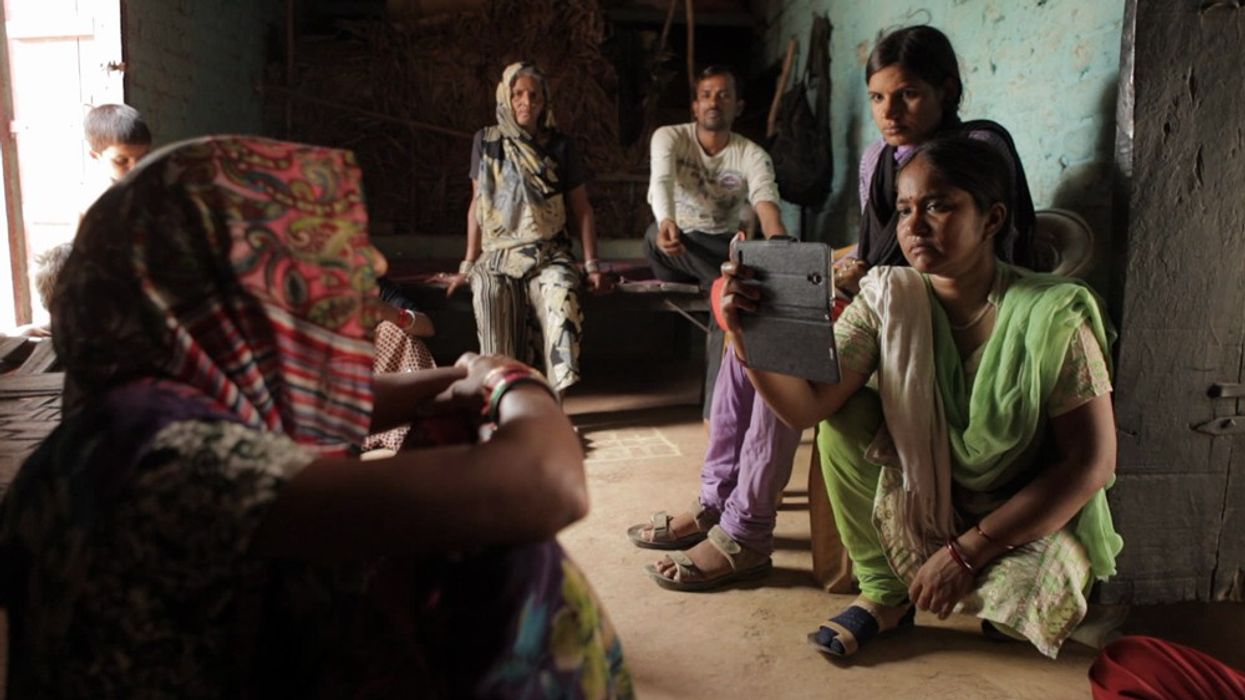How Two Indian Directors Defied the Odds and Exposed the Caste System
The documentary Writing with Fire from director Rintu Thomas and Sushmit Ghosh won two awards at Sundance.

Being born a Dalit (considered the lowest in the caste system of India) means a life of oppression and humiliation. And, if you are a Dalit woman, include gender restrictions and harassment in the package. Since time immemorial, Dalits have been referred to as untouchables, until Mahatma Gandhi in his endeavor for their humanitarian rights called them Harijan (Children of God).
In 2002 when a group of women started Khabar Lahariya (News Waves, an Indian newspaper) with a team of low caste women as reporters, it was not just about female empowerment, but of questioning an age-old hierarchy. Since then, this unique newspaper has been continuing with its grassroots reporting in north Indian states, braving the powers that be.
Khabar Lahariya was introduced to a global audience at the Sundance Festival this year through a documentary, Writing with Fire. It was written, directed, and produced by duo Rintu Thomas and Sushmit Ghosh. And it walked away with two awards: the audience award and the special jury award.
Writing with Fire tells the story of the rise of the newspaper and its digital transformation as it follows three women reporters. On the Sundance webpage, Writing with Fire is described as an electrifying reminder to never underestimate the strength of a woman who’s had enough. “Thanks to the director’s intimate yet respectful lens, we witness these rural reporters’ awe-inspiring efforts to dismantle patriarchy and redefine traditional notions of power.”
No Film School caught up with Thomas and Ghosh after Sundance for insight into their process.

“It took us to Khabar Lahariya,” Thomas said. “The premise was exciting. We first met our characters in 2016. On one hand are Dalit women chipping away at one of the cruel systemic discriminations in the world and on the other hand is digital technology that by its very nature is unfettered. I was interested in exploring what happens when women reclaim the spaces that are designed to exclude them.”
The pre-production challenges lay in crafting a story that works at the intersection of caste, gender, and the role of media.
“In taking an intimate, observational approach to our process of filming, we knew we had the opportunity to locate the story in this rare, dynamic space that the world has not experienced so far,” added Thomas, who with Ghosh started Black Ticket Films (BTF) a production agency in 2009.
From designing branded content to creating socially impactful films as well as fiction and non-fiction series for multiple platforms, they have worked with UNOP, Japan Foundation, McArthur Foundation, Ministry of Information-Govt. of India, and National Geographic Channel to mention some. Among awards received, notable is the Indian national award for their film, Timbaktu (Best Environment Film in 2012). Writing with Fire takes BTF to new heights.
For Writing with Fire, Ghosh picked up his camera to join hands with cinematographer Karan Thapliyal.
“As a cinematographer,” said Ghosh, “I’ve enjoyed working the most on films about ordinary people with extraordinary resilience. For this film, the guiding principle of cinematography has been of mindfulness. Dalit women have always been portrayed as victims of oppression. We decided to show them as confident women whose personalities, personal histories, and dreams are explored in the film.
"How do we visually set up ideas of caste, patriarchy, sexism, and violence without having our characters speak to the camera about them? How do you build an atmosphere of risk, without showing a single image of violence? The cultural landscape of Uttar Pradesh was as important for us as the physical geography in which this story is placed," he said.

“Our presence had to be quiet, our equipment almost invisible so that we didn’t interrupt them,” said Ghosh.
Restricting to a three-member crew, Ghosh, Rintu, and Karan followed Meera, a natural leader, Suneeta, young and ambitious, and Shyamkali, who is silently fierce, through villages in Uttar Pradesh.
The characters worked in extremely hostile spaces, reporting from illegal mines run by powerful mafia, in police stations where rolling a camera is almost impossible, meetings with politicians who are reluctant to be questioned by women with a camera, and in homes of rape survivors, families of murder victims, and domestic violence survivors. Though the cameras stayed close to them, the crew maintained a respectful distance while observing them navigate complex personal realities.
After a few initial interviews, the interview style was discarded. Instead, they went for long, observational takes.
“As we began our shoots, we felt that a powerful story was in the making. Editing small scenes after every schedule helped understand the relationship between what we were filming and what meaning emerged from the footage.”
This film that was five years in the making had its share of roadblocks. Traveling to locations 40-60 kilometers away on rickety buses, overcrowded rickshaws, and eventually on foot in Uttar Pradesh during hot summers, monsoons, and bitter winters was not easy. Besides, they had to regularly ensure their camera lenses were clean in the dusty region. Finally, during editing, they had a four-hour assembly to chip away and arrive at the essence of their film.
“The film centers on three characters, but if we had turned our camera to any of the other 21 women at KL, we would have an equally powerful story,” said Thomas.
Ghosh added, “Our focus has always been to make films that are engaging, entertaining, and easy to access for a global audience.”













